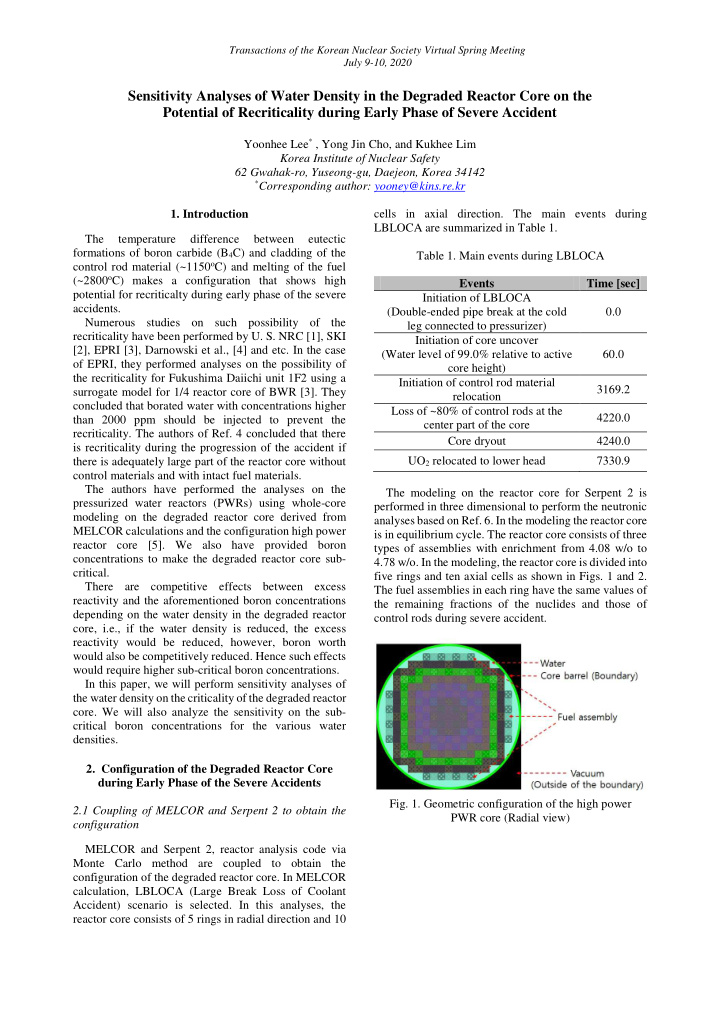



Transactions of the Korean Nuclear Society Virtual Spring Meeting July 9-10, 2020 Sensitivity Analyses of Water Density in the Degraded Reactor Core on the Potential of Recriticality during Early Phase of Severe Accident Yoonhee Lee * , Yong Jin Cho, and Kukhee Lim Korea Institute of Nuclear Safety 62 Gwahak-ro, Yuseong-gu, Daejeon, Korea 34142 * Corresponding author: yooney@kins.re.kr 1. Introduction cells in axial direction. The main events during LBLOCA are summarized in Table 1. The temperature difference between eutectic formations of boron carbide (B 4 C) and cladding of the Table 1. Main events during LBLOCA control rod material (~1150 o C) and melting of the fuel (~2800 o C) makes a configuration that shows high Events Time [sec] potential for recriticalty during early phase of the severe Initiation of LBLOCA accidents. (Double-ended pipe break at the cold 0.0 Numerous studies on such possibility of the leg connected to pressurizer) recriticality have been performed by U. S. NRC [1], SKI Initiation of core uncover [2], EPRI [3], Darnowski et al., [4] and etc. In the case (Water level of 99.0% relative to active 60.0 of EPRI, they performed analyses on the possibility of core height) the recriticality for Fukushima Daiichi unit 1F2 using a Initiation of control rod material 3169.2 surrogate model for 1/4 reactor core of BWR [3]. They relocation concluded that borated water with concentrations higher Loss of ~80% of control rods at the 4220.0 than 2000 ppm should be injected to prevent the center part of the core recriticality. The authors of Ref. 4 concluded that there Core dryout 4240.0 is recriticality during the progression of the accident if there is adequately large part of the reactor core without UO 2 relocated to lower head 7330.9 control materials and with intact fuel materials. The authors have performed the analyses on the The modeling on the reactor core for Serpent 2 is pressurized water reactors (PWRs) using whole-core performed in three dimensional to perform the neutronic modeling on the degraded reactor core derived from analyses based on Ref. 6. In the modeling the reactor core MELCOR calculations and the configuration high power is in equilibrium cycle. The reactor core consists of three reactor core [5]. We also have provided boron types of assemblies with enrichment from 4.08 w/o to concentrations to make the degraded reactor core sub- 4.78 w/o. In the modeling, the reactor core is divided into critical. five rings and ten axial cells as shown in Figs. 1 and 2. There are competitive effects between excess The fuel assemblies in each ring have the same values of reactivity and the aforementioned boron concentrations the remaining fractions of the nuclides and those of depending on the water density in the degraded reactor control rods during severe accident. core, i.e., if the water density is reduced, the excess reactivity would be reduced, however, boron worth would also be competitively reduced. Hence such effects would require higher sub-critical boron concentrations. In this paper, we will perform sensitivity analyses of the water density on the criticality of the degraded reactor core. We will also analyze the sensitivity on the sub- critical boron concentrations for the various water densities. 2. Configuration of the Degraded Reactor Core during Early Phase of the Severe Accidents Fig. 1. Geometric configuration of the high power 2.1 Coupling of MELCOR and Serpent 2 to obtain the PWR core (Radial view) configuration MELCOR and Serpent 2, reactor analysis code via Monte Carlo method are coupled to obtain the configuration of the degraded reactor core. In MELCOR calculation, LBLOCA (Large Break Loss of Coolant Accident) scenario is selected. In this analyses, the reactor core consists of 5 rings in radial direction and 10
Transactions of the Korean Nuclear Society Virtual Spring Meeting July 9-10, 2020 largest among the various configurations during the scenario. Table 2. Computational conditions used in the Serpent 2 Parameter Data Continuous energy Cross section libraries ENDF/B-VII libraries # of particles 50,000 # of inactive cycles 300 # of active cycles 300 Fig. 2. Geometric configuration of the high power PWR core (Axial view) MELSER, an in-house code is used for coupling of the results for MELCOR calculations and input for Serpent 2 for analyses on the criticality of the degraded reactor core. The coupling via MELSER is performed in terms of geometrical degradation of the reactor core and remaining fraction of the isotopes as shown in Fig. 3. Fig. 4. Comparison of criticality for the degraded reactor core with the burnup of 0 GWD/MTU in the equilibrium cycle 3. Sensitivity Analyses of the Water Density on the Criticality of the Degraded Reactor Core With the configuration selected in the previous section, first we perform the sensitivity analyses of the water density on the criticality of the degraded reactor core. For the water densities, we consider 0.1~1.0 g/cm 3 . The computation conditions are shown in Table 2. The criticality for the water density at various burnup are shown in Fig. 5. Note that the criticality becomes larger Fig. 3. Coupling procedure of MELCOR and Serpent 2 as the water densities increase since the water with high for the neutronic analyses of degraded reactor core density provides more effective medium to sustain the chain reactions. 2.2 Selection of Configuration of the Degraded Reactor Core With the modeling on the degraded reactor core, we perform the analyses on the criticality of the core for various configurations obtained from MELCOR calculations. The computation conditions used in this calculations are shown in Table 2. Changes of criticality for various water levels are shown in Fig. 4. From the results, we select the configuration at the time of 4200 sec to perform the sensitivity analyses on the water density in the core since criticality at this time is the
Recommend
More recommend